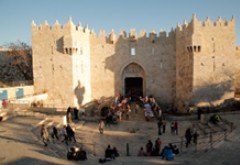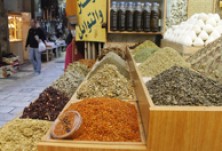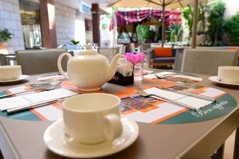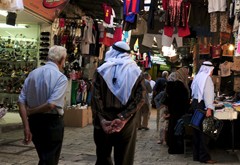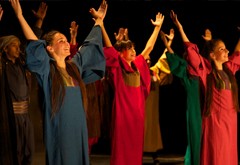It is comprised of three main exhibitions:
- Multimedia [OPEN] – Jerusalem and the Via Dolorosa (the Way of the Cross): from Herod to present day (Monastery of the Flagellation)
- Archaeology [ongoing works, expected opening late 2017] – The evangelical sites of the Holy Land (Monastery of the Flagellation)
- History [next project] – The Franciscan Custody of the Holy Land (St. Saviour Monastery)
THE EXHIBITION “VIA DOLOROSA”
The Via Dolorosa, the first section of the Terra Sancta Museum, is an immersive multimedia installation located at the Monastery of the Flagellation; an ancient tradition identifies the place with the Antonia Fortress and the Praetorian of Pilate.
The visitor is immersed in an environment of lights, sounds, ambient noise, stories and animations, and transported back to the time of Herod in which the dramatic events of the passion, death and resurrection of Christ took place.
The experience, lasting 15 minutes, takes place in three stages, marked by three different multimedia approaches: highlights from the archaeological site and remains from the Herodian and Roman period; the history of Jerusalem through its urban evolution, the worship of the Way of the Cross, evoking the voices of the ancient and illustrious pilgrims.
_________________________
Tickets
15 NIS, 10 NIS for groups (minimum 5 persons), free entrance for children under 12 years
Reservation: [email protected] |+972 (0)585502736 |Facebook
Monastery of the Flagellation, Via Dolorosa 1.
For agencies: vouchers are accepted and available at the entrance of the Terra Sancta Museum. Please note that time schedules are flexible.
Opening hours
April 1 - September 30 from 9 AM to 6 PM (Summer time)
October 1 - March 31 from 9 AM to 5 PM (Winter time)
Languages
English, Italian, Spanish, French, Portuguese, Russian, Arabic and Hebrew.
MONASTERY
OF THE FLAGELLATION
Located at the start of the Via Dolorosa leading to the Holy Sepulchre, this monastery will host the multimedia and the archaeological exhibitions. It is currently the site of the Archaeological Museum of the Studium Biblicum Franciscanum, in operation since 1902 (making it the oldest museum in Israel), which will be restructured and significantly enlarged to give birth to the new archaeological exhibition.
The Monastery of the Flagellation is located in the area of the Antonia Fortress, a roman building constructed next to the Western Wall of the Second Temple. According to the tradition, Jesus was condemned here. Remains of walls, pavements and cisterns can still be visited and will be included in the museum’s archaeological exhibition.
THE ANTONIA FORTRESS AND PRAETORIUM OF PILATE
In the area which an ancient tradition identifies as the Antonia Fortress and the Praetorium of Pilate, where Jesus was condemned and handed over to be crucified, the Studium Biblicum Franciscanum (SBF) has brought to light an important archaeological site with many exceptional remains. The site has been preserved for several years as a “Lapidarium” (storage room) and is part of a late nineteenth-century building of the SBF headquarter. Now, the site houses the “Via Dolorosa” multimedia exhibition.
The archaeological site and the findings have been restored and are displayed in a new, fascinating layout.
The Antonia Tower and the Lithostrotos
Herod the Great (King of Judea from 39 to 4 BC) built a fortress in the north-west corner of the Jewish Temple which he named Antonia Tower, after the Roman general Marc Antony who supported his rise to the throne. According to Christian tradition this is the site of the Lithostrotos, a stone pavement, known in Hebrew as ‘Gabbatha’ (John 19:13) where Jesus appeared before Pontius Pilate and was condemned to death.
After the first Jewish Revolt (66-70 AD), the Roman general Titus destroyed the fortress and after the second Revolt (132-135 AD) Emperor Hadrian rebuilt this area of the city. The pool known as Struthion was covered by a paved square with a monumental arch at its entrance.

